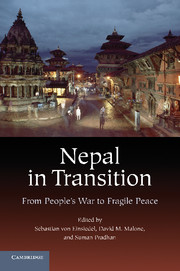Book contents
- Frontmatter
- Contents
- Contributors
- Acknowledgments
- 1 Introduction
- The Context
- 2 The Making of the Maoist Insurgency
- 3 State Power and the Security Sector: Ideologies and Interests
- 4 The Legacy of Nepal's Failed Development
- 5 Ethnic Politics and the Building of an Inclusive State
- Critical Transition and the Role of Outsiders
- Regional Dynamics
- Conclusions
- Index
- References
2 - The Making of the Maoist Insurgency
Published online by Cambridge University Press: 05 April 2012
- Frontmatter
- Contents
- Contributors
- Acknowledgments
- 1 Introduction
- The Context
- 2 The Making of the Maoist Insurgency
- 3 State Power and the Security Sector: Ideologies and Interests
- 4 The Legacy of Nepal's Failed Development
- 5 Ethnic Politics and the Building of an Inclusive State
- Critical Transition and the Role of Outsiders
- Regional Dynamics
- Conclusions
- Index
- References
Summary
In a remote corner of the western Nepal district of Rolpa, in a gently sloping river valley lies the village of Jelbang. Nothing distinguishes this village from the hundreds of others that dot the Nepali mountainside. It does not straddle any of the main trails that crisscross the mountain heartland of Nepal, and unless one purposely intends to visit this village, it is very unlikely to be part of anyone's travel itinerary.
Despite its obscurity, Jelbang stands out in one aspect: although not generally known, this small village (or, more precisely, Jelbang VDC) probably suffered the highest number of deaths during the Maoist conflict of the approximately 4,000 VDCs in Nepal. Sixty-eight people from Jelbang lost their lives, of whom 30 died in the first three years of the fighting, all within the village boundaries.
- Type
- Chapter
- Information
- Nepal in TransitionFrom People's War to Fragile Peace, pp. 37 - 57Publisher: Cambridge University PressPrint publication year: 2012
References
- 15
- Cited by



